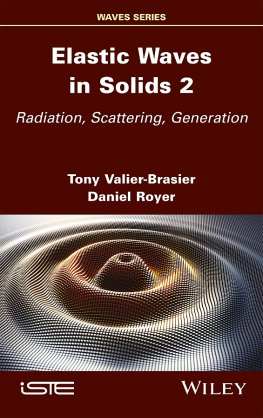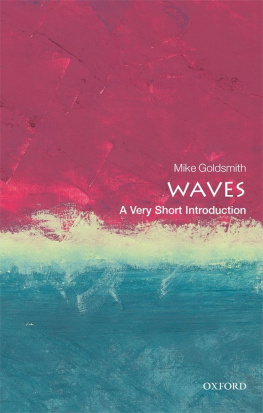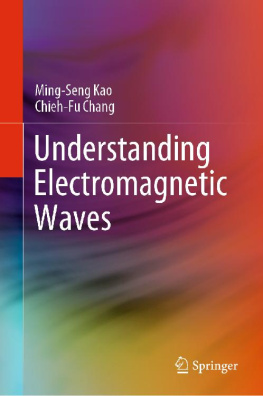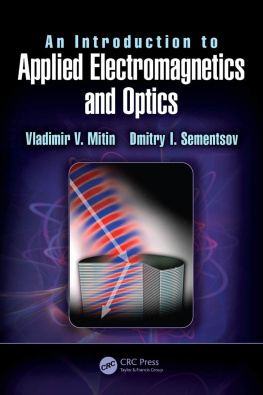Lakhtakia Akhlesh - Electromagnetic surface waves a modern perspective
Here you can read online Lakhtakia Akhlesh - Electromagnetic surface waves a modern perspective full text of the book (entire story) in english for free. Download pdf and epub, get meaning, cover and reviews about this ebook. City: Waltham;MA, year: 2013, publisher: Elsevier Science, genre: Children. Description of the work, (preface) as well as reviews are available. Best literature library LitArk.com created for fans of good reading and offers a wide selection of genres:
Romance novel
Science fiction
Adventure
Detective
Science
History
Home and family
Prose
Art
Politics
Computer
Non-fiction
Religion
Business
Children
Humor
Choose a favorite category and find really read worthwhile books. Enjoy immersion in the world of imagination, feel the emotions of the characters or learn something new for yourself, make an fascinating discovery.

- Book:Electromagnetic surface waves a modern perspective
- Author:
- Publisher:Elsevier Science
- Genre:
- Year:2013
- City:Waltham;MA
- Rating:3 / 5
- Favourites:Add to favourites
- Your mark:
- 60
- 1
- 2
- 3
- 4
- 5
Electromagnetic surface waves a modern perspective: summary, description and annotation
We offer to read an annotation, description, summary or preface (depends on what the author of the book "Electromagnetic surface waves a modern perspective" wrote himself). If you haven't found the necessary information about the book — write in the comments, we will try to find it.
Electromagnetic surface waves a modern perspective — read online for free the complete book (whole text) full work
Below is the text of the book, divided by pages. System saving the place of the last page read, allows you to conveniently read the book "Electromagnetic surface waves a modern perspective" online for free, without having to search again every time where you left off. Put a bookmark, and you can go to the page where you finished reading at any time.
Font size:
Interval:
Bookmark:
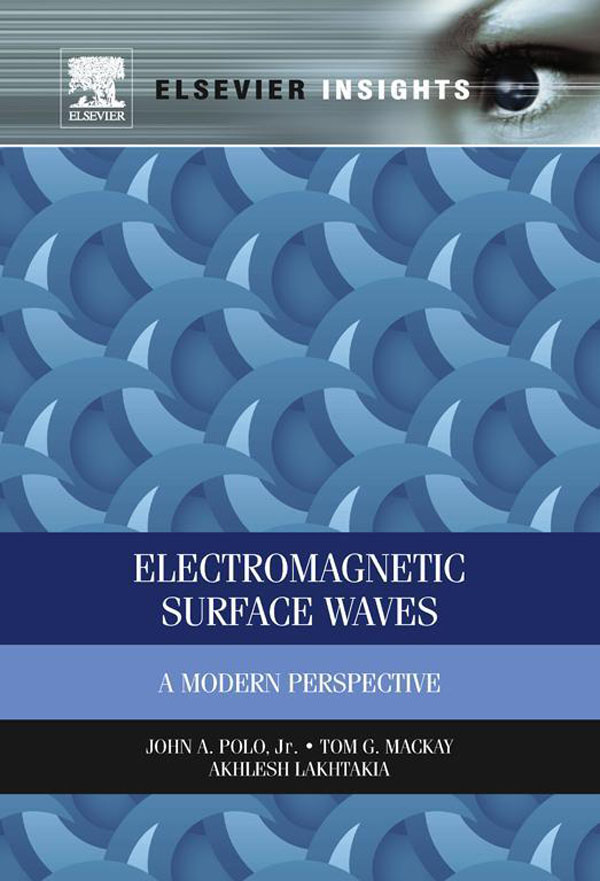
First Edition
Jr. John A. Polo
Department of Physics and Technology Edinboro University of Pennsylvania, Edinboro, PA, USA
Tom G. Mackay
School of Mathematics University of Edinburgh, Edinburgh, UK
Akhlesh Lakhtakia
Department of Engineering Science and Mechanics The Pennsylvania State University, University Park, PA, USA

Elsevier
225 Wyman Street, Waltham, MA 02451, USA
32 Jamestown Road, London NW1 7BY
First edition
Copyright 2013 Elsevier Inc. All rights reserved.
No part of this publication may be reproduced or transmitted in any form or by any means, electronic or mechanical, including photocopying, recording, or any information storage and retrieval system, without permission in writing from the publisher. Details on how to seek permission, further information about the Publishers permissions policies and our arrangements with organizations such as the Copyright Clearance Center and the Copyright Licensing Agency, can be found at our website: www.elsevier.com/permissions.
This book and the individual contributions contained in it are protected under copyright by the Publisher (other than as may be noted herein).
Notices
Knowledge and best practice in this field are constantly changing. As new research and experience broaden our understanding, changes in research methods, professional practices, or medical treatment may become necessary.
Practitioners and researchers must always rely on their own experience and knowledge in evaluating and using any information, methods, compounds, or experiments described herein. In using such information or methods they should be mindful of their own safety and the safety of others, including parties for whom they have a professional responsibility.
To the fullest extent of the law, neither the Publisher nor the authors, contributors, or editors, assume any liability for any injury and/or damage to persons or property as a matter of products liability, negligence or otherwise, or from any use or operation of any methods, products, instructions, or ideas contained in the material herein.
Library of Congress Cataloging-in-Publication Data
A catalog record for this book is available from the Library of Congress
British Library Cataloguing-in-Publication Data
A catalogue record for this book is available from the British Library
ISBN: 978-0-12-397024-4
For information on all Elsevier publications visit our website at
This book has been manufactured using Print On Demand technology. Each copy is produced to order and is limited to black ink. The online version of this book will show color figures where appropriate.

To
His mother, Eunice Polo (19282002)
Jr. John A. Polo
His father, William Mackay (19272012).
Tom G. Mackay
His students who have accompanied him on old and new paths
Akhlesh Lakhtakia
Uniform plane waves are the simplest (nontrivial) solutions of the Maxwell equations in the frequency domain. The components of the field phasors and their spatial variation along a fixed axis are described using a Cartesian coordinate system. In the simplest case, the medium of propagation is a linear and homogeneous material that extends to infinity in all directions. The mathematical apparatus needed here is quite elementary.
Plane waves in air (approximated as vacuum) and isotropic dielectric materials are sufficiently simple to be taught in an undergraduate course using the approach of separation of variables. Plane waves in uniaxial dielectric materials are typically introduced in a first-year graduate course. Plane waves in bianisotropic materials are taught, if at all, in a specialized graduate coursewith a convenient approach provided by the three-dimensional spatial Fourier transform.
Scattering of an incident electromagnetic field occurs at the planar boundary of two half-spaces occupied by dissimilar linear and homogeneous materials. If the incident field is a plane wave, analytical treatment of the reflected and refracted plane waves does not require additional skills beyond the ability to satisfy standard boundary conditions, in exactly the same way as in the undergraduate electromagnetics course. The representation of each plane wavewhether incident, reflected, or refractedinvolves just one material and is obtained after pretending that this material fills all space.
An electromagnetic surface wave, in sharp contrast, is a creature of two materials. The surface wave straddles the planar interface of two half-spaces each occupied by a different material; remove the interface by making the two partnering materials identical, and the surface wave vanishes. Moreover, there is no guarantee that, at a specific frequency, a chosen pair of partnering materials will necessarily support the existence of a surface wave. Thus, a surface wave is far more delicate than a plane wave.
Electromagnetic plane waves have been known in one form or another for several millenniums, but the history of electromagnetic surface waves spans slightly more than a century. Initial progress was sporadic and slow, but the discovery of optical means of launching surface plasmon-polariton waves reported in 1959 led to a quickened pace during the 1970s. At optical frequencies, a surface plasmon-polariton wave is guided by the interface of a metal and a dielectric material (which could be air). Thousands of research papers are published every year on applications of this type of surface wave nowadays, many of the authors having only a beginners knowledge of electromagnetics.
Inevitably, attention began to be paid during the last four decades to other types of electromagnetic surface waves as well. The complexity of partnering materials has increased from isotropic to anisotropic and even to bianisotropic in one sense, and from homogeneous to periodically nonhomogeneous (in the direction normal to the interface) in another sense. These new types of surface waves have not had the vogue experienced by surface plasmon-polariton waves yet, but the spectacular growth of nanotechnologies during the last two decades promises a very bright future for all types of surface waves.
The attraction of surface waves stems from most of the energy of a surface wave being confined to the close vicinity of the interface of the two partnering materials. Any change in the composition of either partnering material in that vicinity could altereven eliminatethe surface wave. Conversely, by engineering the composition close to the interface, a surface wave can be allowed to propagate. At optical frequencies, the close vicinity is often less than a few micrometers. Nanotechnologies allow engineering of composition with a precision of a few nanometers, enabling hitherto unrealizable geometries for field confinement.
From a modern perspective, it does not matter if a partnering material is homogeneous, isotropic, and dielectric or if it is bianisotropic and periodically nonhomogeneous in the direction normal to the interface. A 4 4 matrix formalism can be devised to solve a dispersion equation and then determine the field phasors on each side of the interface. The same formalism can be used to analyze and design a practical prism-coupled configuration for launching a surface wave, and an extension allows treatment of the practical grating-coupled configuration as well. In this way, simple and complex surface plasmon-polariton waves, Zenneck waves, Fano waves, Dyakonov waves, Tamm waves, and Dyakonov-Tamm waves can all be treated in a unified fashion.
Font size:
Interval:
Bookmark:
Similar books «Electromagnetic surface waves a modern perspective»
Look at similar books to Electromagnetic surface waves a modern perspective. We have selected literature similar in name and meaning in the hope of providing readers with more options to find new, interesting, not yet read works.
Discussion, reviews of the book Electromagnetic surface waves a modern perspective and just readers' own opinions. Leave your comments, write what you think about the work, its meaning or the main characters. Specify what exactly you liked and what you didn't like, and why you think so.

